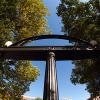Jeff Speck on Bike Safety, Closing College Square and Charging More to Park in Downtown Athens

About 50 Athens-Clarke officials and neighborhood leaders attended an Athens-Clarke Heritage Foundation workshop today with noted New Urban planner Jeff Speck. Here are a few quick takeaways, including why we should reconsider downtown parking rates, how to make the city safe and inviting for pedestrians and bicyclists, and why we should think twice before we close College Square.
• Downtown is "not that screwed up." The "basic bones... look pretty good." Our city blocks are small, which encourages walkability. But other nodes in the city need help. Rather than "sprinkle magic walkability fairly dust" evenly, we should focus on the areas where it'll do the most good.
• Cities that want to attract millennials, professionals and corporations need to be walkable. To be walkable, cities need safe places to walk and interesting places to walk to. The post-World War II idea of separating housing from shopping from workplaces is discredited. Young people and retirees don't want to live in suburban sprawl. "The new economy is being a place where people want to be, because people can live wherever they want."
• Walkability is a health issue. When cities are designed for cars, people are forced to drive. "This is why we have obese children, because they can't get anywhere under their own steam."
• Downtowns have too much parking, and it's too cheap, mainly because cities require too much parking. Let the free market decide how much parking to build and what to charge for it. Businesses flourish when parking is available, and parking is available when it's expensive. The more convenient it is, the more it should cost. (In Athens, it's the opposite; decks are twice as much as parking on the street.) Merchants will fight it, but they're wrong, and they'll change their minds if the revenue is reinvested downtown.
• But as long as streets are narrow enough to cross safety, cars encourage walking. People tend to not walk on streets with no cars, and parked cars form a barrier against moving vehicles.
• Speaking of streets with no cars, Speck warned against closing College Square to vehicles. About 200 pedestrian malls have been built, 150 failed and only 10 really work. Those 10, though, are in college and resort towns. We should experiment with closing the block to see how it affects traffic and retailers before going through with it permanently.
• Urban streets are often designed to highway standards, and they shouldn't be. Wide lanes and too many of them encourage people to drive more and go faster. Often such streets don't even carry that much traffic, or engineers invited the traffic by widening them. They're dangerous for people on foot. "I'm sure the Georgia DOT has killed more Georgians than all wars combined."
• One-way streets are bad for retailers (who see a loss of business if they're not on a street people use when coming home from work), pedestrians (who are intimidated by all the cars going the same way) and drivers (because their trips take longer). But Athens' one-way streets downtown seem to be working.
• Medians, street trees, on-street parking, pedestrians and cyclists will slow down drivers, thus making the streets safer for pedestrians and cyclists. There's safety in numbers. The more cyclists on the road, the lower the accident rate drops, because drivers are more aware. The safest form of on-street parking is angled spots drivers back into (which people hate, but keeps them from backing out into the street). Safe bike routes with buffers separating bike lanes from vehicular lanes encourage biking among women and children (who are less macho than men who want to claim the lane).
• Walkability requires density, usually about 20 housing units per acre. (Suburbia has about two per acre.) That's the traditional density of old cities and urban neighborhoods, which are usually about a half-mile across, so you can walk from the (well-deliniated) edge to the (denser) center in five minutes.
• How does that density fit in with our historic structures? Apartment buildings can be compatible if they're to scale, or historic houses can be retrofitted to multifamily. The main challenge is parking. Again, get rid of parking minimums.
• Paging Nancy Denson (who has attended the National Endowment for the Art's Mayors' Institute on City Design, which Speck used to run): "It doesn't matter if it's a strong mayor or weak mayor. Any mayor who has that bully pulpit can transform the shape and feel of their city."












comments